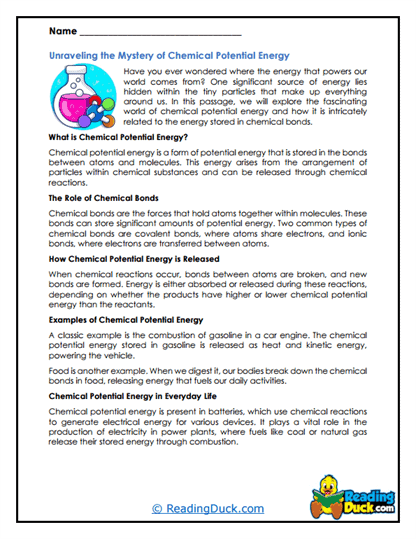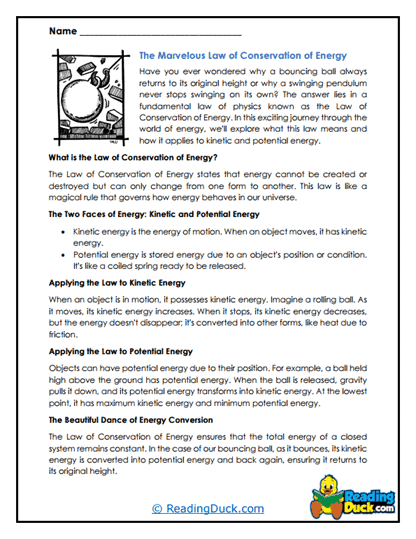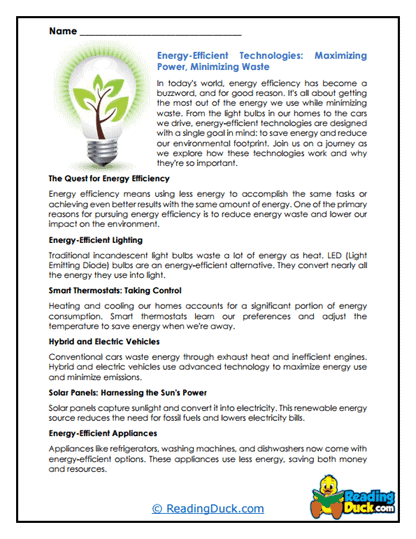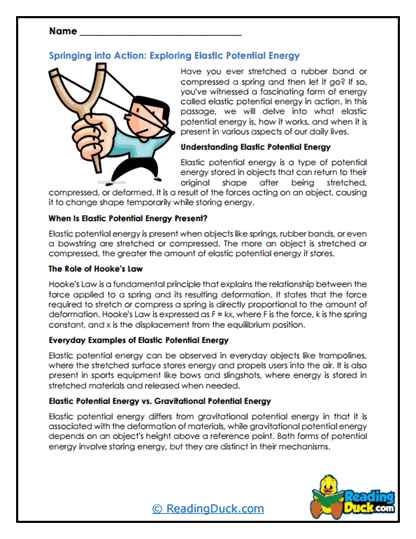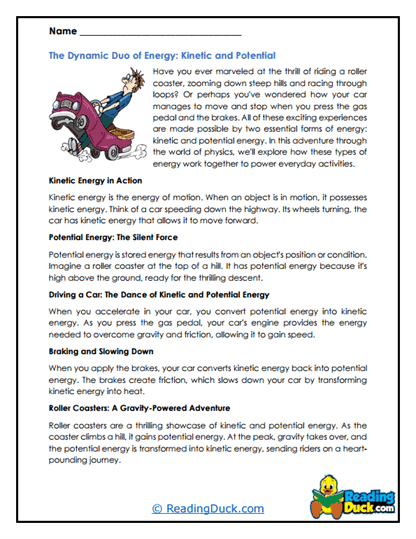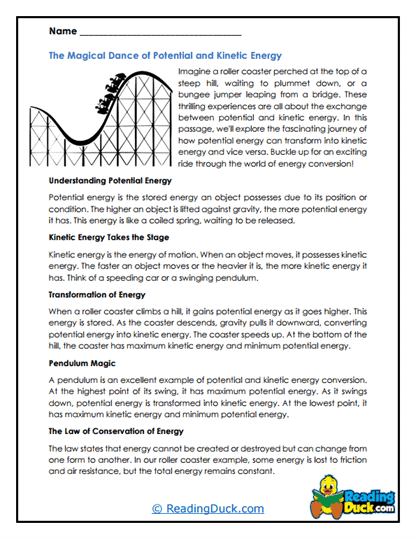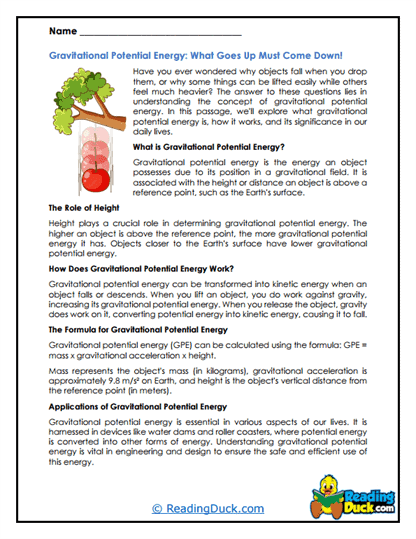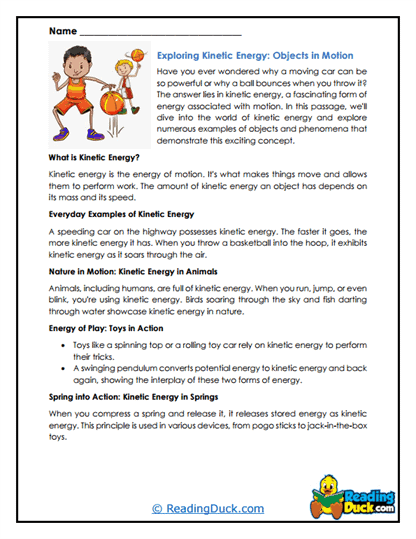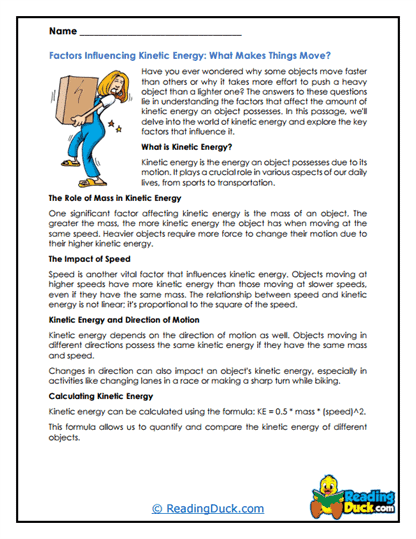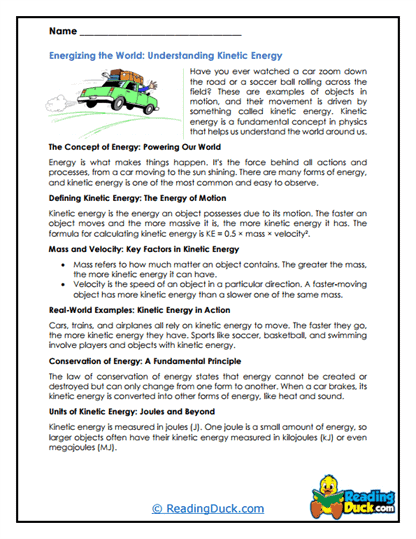Kinetic and Potential Energy Worksheets
About Our Kinetic and Potential Energy Worksheets
Our collection of Kinetic and Potential Energy worksheets is a vital resource for students exploring the fundamental concepts of energy within the field of Chemistry. Kinetic and potential energy are key principles that help students understand how energy is stored, transferred, and transformed in various systems. These worksheets offer a thorough exploration of these concepts, making them an essential tool for educators and learners alike.
This collection contains numerous worksheet sets, each designed to engage students with a variety of learning activities:
- Multiple Choice Questions: These questions test students’ understanding of core concepts like the differences between kinetic and potential energy, the factors that influence these types of energy, and real-world examples of energy transformations.
- Short Answer Questions: These prompts encourage students to express their knowledge in their own words, such as explaining how energy is conserved in a closed system or describing the relationship between mass, velocity, and kinetic energy.
- Open-Ended Questions: These questions invite students to reflect on and analyze scenarios where kinetic and potential energy play a crucial role, such as in roller coasters or pendulums, encouraging deeper critical thinking.
These worksheets not only assess students’ comprehension but also foster a deeper connection to the material. Each worksheet set is accompanied by an answer key to support learning and self-assessment. All worksheets are provided as PDF files, which can be easily viewed electronically, downloaded, and printed out.
Understanding Energy: The Dynamics of Kinetic and Potential Energy
1. What is Energy?
- Definition and Basic Concepts:
- Energy as a Fundamental Concept: Energy is the ability to do work, and it exists in various forms, including kinetic energy (energy of motion) and potential energy (stored energy due to position or configuration).
- The Law of Conservation of Energy: This fundamental principle states that energy cannot be created or destroyed, only transferred or converted from one form to another.
2. Kinetic Energy: The Energy of Motion
- Defining Kinetic Energy:
- Formula and Calculation: Kinetic energy (KE) is calculated using the formula KE = ½ mv², where 'm' is mass and 'v' is velocity. This formula shows that kinetic energy increases with both mass and the square of velocity.
- Examples of Kinetic Energy:
- In Everyday Life: Moving vehicles, flowing water, and even walking or running all involve kinetic energy.
- In Natural Phenomena: Wind is a form of kinetic energy that can be harnessed for electricity, while flowing rivers can drive turbines.
3. Potential Energy: Energy Stored in Position
- Defining Potential Energy:
- Types of Potential Energy:
- Gravitational Potential Energy: This type of energy is due to an object’s position relative to a gravitational field, calculated using PE = mgh, where 'm' is mass, 'g' is gravitational acceleration, and 'h' is height.
- Elastic Potential Energy: Energy stored in objects that can be stretched or compressed, such as springs or rubber bands.
- Chemical Potential Energy: Energy stored within chemical bonds, which is released during chemical reactions.
- Examples of Potential Energy:
- In Everyday Life: A book on a shelf (gravitational potential energy), a compressed spring (elastic potential energy), or a charged battery (chemical potential energy).
- In Nature: Water held behind a dam (gravitational potential energy) or energy stored in the bonds of food molecules.
- Types of Potential Energy:
4. The Interplay Between Kinetic and Potential Energy
- Energy Transformation:
- Kinetic and Potential Energy Conversions: In many systems, kinetic and potential energy continuously convert into each other. For example, a pendulum alternates between maximum potential energy at the highest points and maximum kinetic energy at the lowest point.
- Real-World Applications:
- Roller Coasters: As the coaster climbs a hill, it gains potential energy, which converts to kinetic energy as it descends.
- Hydropower: Water held in a reservoir has potential energy, which is converted into kinetic energy as it flows through turbines, generating electricity.
Activities to Supplement These Worksheets
To enhance the learning experience provided by the Kinetic and Potential Energy worksheets, teachers and parents can engage students in hands-on activities and creative projects that reinforce the concepts covered. Here are some suggestions:
1. Energy Transformation Experiments:
- Pendulum Experiment:
- Activity: Have students construct a simple pendulum using string and a weight. By observing the pendulum’s motion, students can see the continuous conversion between kinetic and potential energy. Measure the height and speed at different points to calculate the energy values.
- Objective: This experiment helps students visualize and understand the principles of energy conservation and transformation in a tangible way.
- Roller Coaster Simulation:
- Activity: Using materials like cardboard and marbles, students can build a model roller coaster. They can experiment with different heights and track designs to observe how potential energy at the top converts to kinetic energy as the marble rolls down.
- Objective: This hands-on activity allows students to apply their knowledge of kinetic and potential energy to a real-world scenario, enhancing their understanding of energy dynamics.
2. Real-Life Applications of Energy:
- Exploring Energy in Sports:
- Activity: Assign students to analyze the kinetic and potential energy in different sports, such as a basketball player jumping for a shot (potential energy at the peak of the jump) or a sprinter accelerating from the starting line (kinetic energy).
- Objective: This activity connects abstract energy concepts to familiar physical activities, making the learning more relatable and engaging.
- Energy in Everyday Objects:
- Activity: Have students identify and describe the energy transformations that occur in common household objects, such as a toaster (electrical energy to thermal energy), a clock pendulum (kinetic and potential energy), or a battery-operated toy (chemical energy to kinetic energy).
- Objective: This exercise helps students see the relevance of energy concepts in their daily lives, reinforcing the practical importance of understanding kinetic and potential energy.
3. Creative Projects:
- Energy in Art:
- Activity: Encourage students to create visual art projects that represent the concepts of kinetic and potential energy. For example, they could draw or paint scenes that depict energy transformations, like a waterfall (potential to kinetic energy) or a sunset (solar energy converting to heat).
- Objective: Integrating art into science lessons helps students express their understanding creatively, catering to different learning styles.
- Energy Storytelling:
- Activity: Have students write short stories or create comic strips where the main characters are "Kinetic Energy" and "Potential Energy." The characters could go on adventures where they switch roles and demonstrate energy transformations.
- Objective: This activity encourages students to think creatively about energy concepts and to explain them in their own words, reinforcing their understanding through narrative.
4. Interactive Digital Tools:
- Virtual Labs:
- Activity: Use online virtual labs and simulations that allow students to manipulate variables in experiments related to kinetic and potential energy. These tools can demonstrate concepts like energy conservation, the effect of mass and velocity on kinetic energy, and the impact of height on potential energy.
- Objective: Virtual labs provide a safe and flexible environment for students to explore energy concepts, offering an interactive way to experiment and learn.
- Energy Apps:
- Activity: Introduce students to educational apps that focus on energy topics. These apps might include games or quizzes that reinforce the principles of kinetic and potential energy, making learning fun and interactive.
- Objective: Using technology to learn about energy engages students in a modern and accessible way, encouraging them to explore the concepts further.
5. Group Discussions and Presentations:
- Debate: Kinetic vs. Potential Energy:
- Activity: Organize a class debate where students are divided into two groups—one representing kinetic energy and the other potential energy. Each group presents arguments on why their type of energy is more important or impactful in various scenarios.
- Objective: This debate format fosters critical thinking and teamwork, while deepening students' understanding of both types of energy.
- Energy Transformation Presentations:
- Activity: Assign each student or group a specific energy transformation (e.g., potential to kinetic in a falling object) and have them create a presentation explaining the process, including real-world examples and diagrams.
- Objective: This activity develops students’ research and presentation skills while reinforcing their knowledge of energy transformations.
By supplementing the Kinetic and Potential Energy worksheets with these activities, teachers and parents can create a dynamic and engaging learning environment. These activities not only reinforce the theoretical concepts covered in the worksheets but also encourage students to apply their knowledge in practical, creative, and interactive ways.
